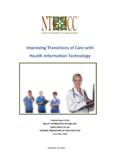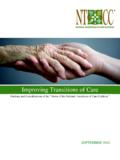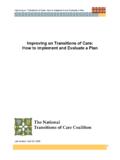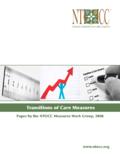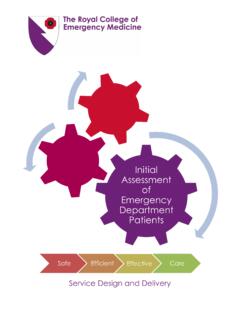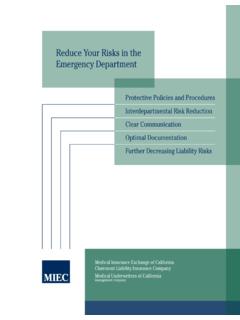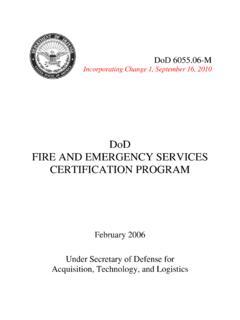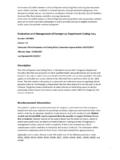Transcription of Improving Transitions of Care: Emergency …
1 Improving Transitions of care : Emergency department to Home Improving Transitions of care : Emergency department to Home Last Revised: October 2009. National Transitions of care Coalition 1. Improving Transitions of care : Emergency department to Home Acknowledgement This guidebook was written and compiled by Insight Therapeutics, LLC, ( ) and represents expert opinion. The Performance & Metrics Work Group of NTOCC provided strategic direction through its work in defining a framework for measuring transitional care and review of various guidebook drafts. NTOCC Performance & Metrics Work Group Mary Fermazin, MD, MPA. VP, Health Policy & Quality Measurement Health Services Advisory Group, Inc. (HSAG).
2 Hussein Tahan, DNSc, RN, CNA. New York Presbyterian Hospital James E. Lett II, MD, CMD. Chief Medical Officer for Long-Term care California Prison Health care Services Lisa McGonigal, MD, MPH. Program Director National Quality Forum (NQF). Marci Weis, RN, MPH, CCM. COO, care Management - Qualis Health Funding Acknowledgement This project was funded under a contract from NTOCC, which is chaired and coordinated by the Case Management Society of America and sponsored by sanofi-aventis LLC. For more information Please visit the NTOCC website, , for additional information. 2. Improving Transitions of care : Emergency department to Home CONTENTS. Forward .. 4. 5. 5. Evaluating and Improving Transitions of care in Your Institution.
3 8. Step 1. Select What You Plan to 8. Step 2. Assess the Current Process .. 9. Step 3. Determine Your Current Level of Performance .. 15. Step 4. Determining Your Intervention Strategy .. 23. Step 5. Implementing Your Intervention 26. Step 5. Implementing Your Intervention 27. Step 6. Determine Your Degree of 28. Step 7. Make Any Modifications Necessary to the 29. Appendix A: Preparation in ED to Discharge Patient Home .. 33. Appendix B: Patient or Family/caregiver Takes Over care Coordination .. 40. Appendix C. Quality Indicators for Geriatric Emergency 45. Appendix D. Assessing care of Vulnerable Elders-3 Quality 46. Appendix E. The Communication Assessment Tool for Use in Team Settings (CAT-T).
4 49. Appendix F: Literature Review - Transitions from the ED to 50. Appendix G: Institute for Healthcare Improvement Tips for Effective Measures .. 53. Appendix H: NTOCC 54. Suggested Common/Essential Data Elements for Medication Reconciliation .. 54. My Medicine List .. 54. Taking care of My Health 55. Elements of Excellence in Transitions of care (TOC) 55. Appendix I: NTOCC Proposed Framework for Measuring Transitions of 56. Appendix J: Annotated Bibliography and References .. 57. Appendix K. Sample Emergency department (ED) Discharge Instruction 61. Appendix L: transition of care Intervention 63. 3. Improving Transitions of care : Emergency department to Home Forward NTOCC believes in the commitment of healthcare workers, practitioners, and leaders and in their ability to make a difference in Improving Transitions of care .
5 To further NTOCC's reach for Improving the quality of care Transitions , we have added to our Implementation and Evaluation Plan by offering this additional module: the Emergency department to home transition . The methodology used here is the same for the introductory module released in 2008 implement a plan and evaluate it to see how it is working. This document is intended to be used in conjunction with the original document, Improving on Transitions of care : How to Implement and Evaluate a Plan.. This plan includes evaluation questions, acceptable metrics or measures, tools, and tips applicable to Emergency departments, home caregivers, and primary care offices. As with other NTOCC. strategies, communication is the most important component of any plan, tool, or quality improvement effort.
6 Thank you for your continued dedication to making Transitions safer. Cheri Lattimer Executive Director, Case Management Society of America NTOCC Project Director 4. Improving Transitions of care : Emergency department to Home Introduction Patients face significant challenges when moving from one care setting to another within the fragmented health care system. As currently structured, the health care system does not meet the needs of many patients during Transitions between health care settings. The system's problems have culminated in medical errors and gross mismatches of health care resources to needs. (Chassin MR et al. JAMA 1998) Not only can poor Transitions lead to poor care quality, Transitions of care issues pose a financial burden for the health insurers, the government, and patients.
7 A constant in all episodes of care is the patient, who, with sufficient education, cultural and health literacy consideration, and empowerment can proactively facilitate necessary communication and interaction between providers. Exceptions include those with cognitive deficits, in which an empowered caregiver is a necessity. In order to improve health care in this country, patients and providers must ensure better information exchange at all stages of the health care process, and patients and their caregivers should actively participate in a standardized communication plan. Background The term " Transitions of care " connotes the scenario of a patient leaving one care setting ( hospital, Emergency department (ED), nursing home, assisted living facility, skilled nursing facility, primary care physician, home health, or specialist) and moving to another.
8 The care transition frequently involves multiple persons, including the patient, family or other caregiver, nurses, social workers, case manager, pharmacists, physicians, and other providers. An optimal transition should be well-planned and sufficiently timed. Research has shown that communication between settings or providers often fails to supply all of the information needed for optimum care . Several studies in recent years have shown that deficiencies in health literacy, patient education, appropriate medical follow-up, and communication among health care providers to be associated with adverse event risk following ED discharge. The Office of the Inspector General reported in 2006. that 34,500 patients in 1996 and 1997 were discharged and readmitted on the same day, costing the system more than $226 million.
9 ( ) In 2008, investigators reported that an estimated million Emergency visits were by persons who had been discharged from the hospital within the previous 7 days. Medication-related problems are a major concern in the ED. Recent evidence suggests that medication lists compiled as part of the medication reconciliation process in the ED are not accurate (Caglar S. J Emerg Med 2008). The identified errors included omitted medications (56%) and dosing 5. Improving Transitions of care : Emergency department to Home or frequency errors (80%); 87% of medication lists had at least one error. Another study showed that during triage, almost 50% of patients had one medication that was missed and 27% of the cases were related to the patient's chief complaint.
10 (Shepherd G. AJHP 2009). The ED discharge process can also be fraught with problems. In a recent study of patient and caregiver understanding of discharge instructions, the investigators assessed patient and caregiver understanding of discharge instruction in 4 domains: 1) diagnosis and cause, 2) ED care , 3) post-ED. care , and 4) return instructions. Seventy-eight percent of participants demonstrated deficient comprehension in at least 1 domain. Greater than one-third of the deficiencies involved understanding of post-ED care . The authors concluded that many patients do not understand their ED care or their discharge instructions. (Engel KG et al. Ann Emerg Med 2009). Adverse events are another concern following ED discharge.

